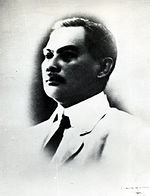Alternative Parties in the Philippines: Partido Progresista
***
The Partido Progresista was, in essence, the revival of the Partido Federalista. The Federalistas, dissolved as a party by 1906, had regrouped in 1907 to participate in the first Philippine Assembly elections that same year. The revival saw not only a name change but also a platform change. During the party’s national convention, the party manifesto was released, outlining their aims, which said in part:
 |
| Arsenio Cruz-Herrera Photo courtesy of Wikipedia |
In order to avoid erroneous interpretations, it becomes necessary to announce that the change above referred to is made solely in response to constant and repeated requests from appreciative adherents, principally from the provinces, who consider it unwise, and a misnomer to continue using the word “Federal” after our political group had adopted independence as the ultimate end.The Federalista annexation program was changed to an independence platform. The national convention had elected Arsenio Cruz-Herrera, a former member of the Malolos Congress and regarded as Manila's first Filipino mayor, as party president. However, while the Federalista Party enjoyed being the most successful in the Philippines before the 1907 elections, the Partido Progresista, or the Progresista Party, failed to capture the mantle of the independence program from the emerging Nacionalistas. Thus, the party had won only 16 of the 80 seats of the first Philippine Assembly. One of the party’s winning candidates, Vicente Encarnacion Singson of Ilocos Sur, was elected Minority Floor Leader. Cruz-Herrera failed to win the seat of Rizal province’s first legislative district.
In Philippine politics, the National Progressive Party will continue to fulfill the same mission as that carried out until now by the Federal Party, that of constituting in the Philippines in due time a independent democratic government...
It is not to say, however, that the annexation platform and pacification program of the Federalistas had almost absolute popular backing, and that the independence platform developed only later. The prosperity of the Federal Party from its establishment in 1900 was owed from official recognition by the American colonial government. The Federalistas’ own platforms had made themselves favoured by the Americans. Also, it was the same colonial government that prohibited the formation and recognition of political parties with an independence platform. Therefore, any man aspiring for a political position at the time will have no choice than to be affiliated with the Federal Party. The revocation of the prohibition on an independence platform reflected on the 1907 elections, which put the Progresistas, unable to overcome their annexation image, at a disadvantage. Still, they remained to be the leading opposition party. In the 1909 election, the party won 17 of 81 seats. In the 1912 election, they had 16 of 81 seats. Lastly, their last electoral performance in 1916 made them garner 7 of 90 seats in the Lower House and only one of 24 in the Senate.
By 1917, due to their bad electoral showing the preceding year, it fused with the Democrata Nacional Party to form the Democrata Party.
***






Comments
Post a Comment